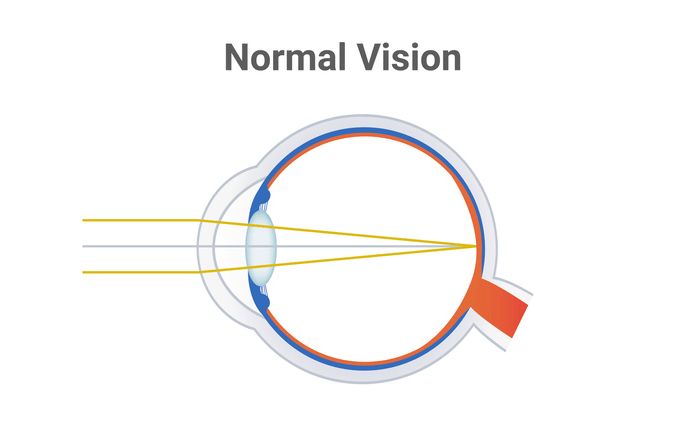What is emmetropia?

Emmetropia ("em-eh-TROE-pee-ah") is the medical term for naturally occurring clear vision. In other words, a person with emmetropia does not have any refractive errors — such as nearsightedness (myopia), farsightedness (hyperopia) or astigmatism. Someone with emmetropia has clear vision at all distances without corrective lenses and without squinting or straining their eyes.
When light enters an emmetropic eye, an image focuses perfectly on the retina. This is unlike nearsightedness, in which light focuses images in front of the retina, or farsightedness, in which light focuses images behind the retina.
In cases of hyperopia, the eyeball is a little too short from front to back; in myopia, the eyeball is slightly too long. Emmetropic eyes are just the right length to allow light to reach the ideal spot on the retina to create crisp, clear vision.
A person with two emmetropic eyes is considered to have “ideal vision” and does not require any sort of vision correction. Emmetropia is often given as the medical definition for 20/20 vision.
What causes emmetropia?
Emmetropia occurs when there is perfect balance between the length and the optical power of the eye. Not much is known about why some people’s eyes develop with this ideal balance while others’ eyes develop a bit long or short. Scientists believe it may involve many factors ranging from genetics to visual input in the environment.
Does emmetropia require treatment?
Because emmetropic eyes naturally produce 20/20 vision, no corrective treatment is needed to aid in visual clarity. However, people who have emmetropia can still develop other eye conditions that should receive proper attention and treatment.
Emmetropia vs. ametropia (refractive errors)
Emmetropia is the absence of refractive errors in the eye. Ametropia is the opposite — it means the eyes have refractive errors. Ametropia is an umbrella term that includes the four main types of refractive errors:
Hyperopia (farsightedness) – Distant objects appear clear, but nearby objects appear blurry. This condition can be hereditary and is treated with corrective lenses such as eyeglasses or contact lenses.
Myopia (nearsightedness) – Nearby objects appear clear, but objects that are far away appear blurry. Like hyperopia, myopia can be hereditary and is corrected with eyeglasses or contacts. Myopia often occurs in childhood but can be developed in adulthood as well.
Astigmatism – Both near and distant objects appear blurry because the cornea is irregularly curved. Astigmatism often accompanies myopia or hyperopia. Treatment for astigmatism includes eyeglasses or contacts.
Hyperopia, myopia and astigmatism can also be treated with refractive surgery if it is recommended by an eye doctor.
Presbyopia
Presbyopia, or age-related farsightedness, is a natural part of the aging process of the eye’s lens. It usually begins around age 40, when the lens starts to lose some flexibility, and it affects everyone.
Presbyopia is considered a refractive error. However, it is not related to the length of the eye or the shape of the cornea or lens, like other types of ametropia. This means that even people who have always had emmetropic vision can develop presbyopia.
Presbyopia can be treated with reading glasses, which are available over the counter.
Protecting emmetropic eyes
Emmetropic eyes do not require corrective lenses, but that doesn’t make them any less susceptible to conditions unrelated to visual acuity. The best way to promote healthy vision is through proper care and preventative measures, from basic eye protection to routine eye exams.
UV protection
UV rays can be harmful to the eyes, regardless of vision clarity. In fact, too much exposure to sunlight can increase your risk of sunburned eyes, cataracts, snow blindness, eye cancer and growths in or near the eye.
Be sure to protect your eyes from the brightness of the sun with 100% UV or UV400 protection in your sunglasses.
Additional eye protection
If you work outdoors or participate in sports or other activities that could potentially harm your eyes, it is important to know what kind of protective eyewear you need. Sports glasses or safety goggles, in addition to UV protection, are key in preventing eye injuries that could complicate vision.
Some people who spend a great deal of time looking at computers find that blue light glasses are beneficial for keeping them comfortable while working on their devices.
Routine eye exams
Regardless of the natural sharpness of your vision, certain conditions can develop with age or due to your family’s medical history.
Annual comprehensive eye exams are the best way to detect any abnormalities or changes in vision. The earlier a problem is detected, the sooner it can be corrected. If you have any concerns with your vision, do not hesitate to contact your eye doctor.
READ NEXT: Eye exams: 5 reasons why they are important
Definitions of myopia and other related terms. Myopia: Prevention and Control. Accessed March 2021.
Presbyopia: Everything you need to know. American Refractive Surgery Council. July 2016.
The sun, UV light and your eyes. American Academy of Ophthalmology. June 2020.
Safety glasses and protective eyewear. American Academy of Ophthalmology. March 2019.
Page published on Wednesday, April 14, 2021






